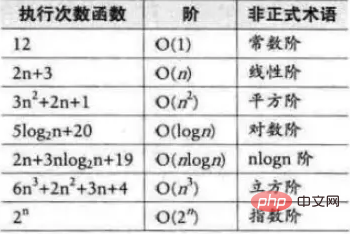data structure time complexity

What is time complexity?
A certain function in the algorithm has n basic operations repeated, represented by T(n). Now there is an auxiliary function f(n), so that when n approaches infinity, T If the limit value of (n)/f(n) is a constant that is not equal to zero, then f(n) is said to be a function of the same order of magnitude as T(n), recorded as T(n)=O(f(n)), and is called O (f(n)) is the asymptotic time complexity of the algorithm, referred to as time complexity.
In layman terms, the so-called time complexity is to find a function f(n) of the same curve type to represent the trend of this algorithm as n continues to increase. When the input quantity n gradually increases, the limit case of time complexity is called the "asymptotic time complexity" of the algorithm.
Method for calculating time complexity:
1. Use constant 1 to replace all addition constants in the running time
2. Modification In the final number of runs function, only the highest order term
3 is retained, and the coefficients of the highest order term
are removed and arranged in increasing order of magnitude. Common time complexities are:

The above is the detailed content of data structure time complexity. For more information, please follow other related articles on the PHP Chinese website!

Hot AI Tools

Undresser.AI Undress
AI-powered app for creating realistic nude photos

AI Clothes Remover
Online AI tool for removing clothes from photos.

Undress AI Tool
Undress images for free

Clothoff.io
AI clothes remover

AI Hentai Generator
Generate AI Hentai for free.

Hot Article

Hot Tools

Notepad++7.3.1
Easy-to-use and free code editor

SublimeText3 Chinese version
Chinese version, very easy to use

Zend Studio 13.0.1
Powerful PHP integrated development environment

Dreamweaver CS6
Visual web development tools

SublimeText3 Mac version
God-level code editing software (SublimeText3)

Hot Topics
 1385
1385
 52
52
 Compare complex data structures using Java function comparison
Apr 19, 2024 pm 10:24 PM
Compare complex data structures using Java function comparison
Apr 19, 2024 pm 10:24 PM
When using complex data structures in Java, Comparator is used to provide a flexible comparison mechanism. Specific steps include: defining the comparator class, rewriting the compare method to define the comparison logic. Create a comparator instance. Use the Collections.sort method, passing in the collection and comparator instances.
 How to analyze the time complexity of C++ recursive functions?
Apr 17, 2024 pm 03:09 PM
How to analyze the time complexity of C++ recursive functions?
Apr 17, 2024 pm 03:09 PM
Time complexity analysis of recursive functions involves: identifying base cases and recursive calls. Calculate the time complexity of the base case and each recursive call. Sum the time complexity of all recursive calls. Consider the relationship between the number of function calls and the size of the problem. For example, the time complexity of the factorial function is O(n) because each recursive call increases the recursion depth by 1, giving a total depth of O(n).
 How to deal with time complexity issues in PHP functions?
Apr 26, 2024 pm 02:12 PM
How to deal with time complexity issues in PHP functions?
Apr 26, 2024 pm 02:12 PM
Time complexity is a measure of how long a function takes to execute. Common PHP function time complexity problems include nested loops, large array traversals, and recursive calls. Techniques for optimizing time complexity include: using caching to reduce the number of loops simplifying algorithms using parallel processing
 Java data structures and algorithms: in-depth explanation
May 08, 2024 pm 10:12 PM
Java data structures and algorithms: in-depth explanation
May 08, 2024 pm 10:12 PM
Data structures and algorithms are the basis of Java development. This article deeply explores the key data structures (such as arrays, linked lists, trees, etc.) and algorithms (such as sorting, search, graph algorithms, etc.) in Java. These structures are illustrated through practical examples, including using arrays to store scores, linked lists to manage shopping lists, stacks to implement recursion, queues to synchronize threads, and trees and hash tables for fast search and authentication. Understanding these concepts allows you to write efficient and maintainable Java code.
 PHP data structure: The balance of AVL trees, maintaining an efficient and orderly data structure
Jun 03, 2024 am 09:58 AM
PHP data structure: The balance of AVL trees, maintaining an efficient and orderly data structure
Jun 03, 2024 am 09:58 AM
AVL tree is a balanced binary search tree that ensures fast and efficient data operations. To achieve balance, it performs left- and right-turn operations, adjusting subtrees that violate balance. AVL trees utilize height balancing to ensure that the height of the tree is always small relative to the number of nodes, thereby achieving logarithmic time complexity (O(logn)) search operations and maintaining the efficiency of the data structure even on large data sets.
 In-depth understanding of reference types in Go language
Feb 21, 2024 pm 11:36 PM
In-depth understanding of reference types in Go language
Feb 21, 2024 pm 11:36 PM
Reference types are a special data type in the Go language. Their values do not directly store the data itself, but the address of the stored data. In the Go language, reference types include slices, maps, channels, and pointers. A deep understanding of reference types is crucial to understanding the memory management and data transfer methods of the Go language. This article will combine specific code examples to introduce the characteristics and usage of reference types in Go language. 1. Slices Slices are one of the most commonly used reference types in the Go language.
 Full analysis of Java collection framework: dissecting data structure and revealing the secret of efficient storage
Feb 23, 2024 am 10:49 AM
Full analysis of Java collection framework: dissecting data structure and revealing the secret of efficient storage
Feb 23, 2024 am 10:49 AM
Overview of Java Collection Framework The Java collection framework is an important part of the Java programming language. It provides a series of container class libraries that can store and manage data. These container class libraries have different data structures to meet the data storage and processing needs in different scenarios. The advantage of the collection framework is that it provides a unified interface, allowing developers to operate different container class libraries in the same way, thereby reducing the difficulty of development. Data structures of the Java collection framework The Java collection framework contains a variety of data structures, each of which has its own unique characteristics and applicable scenarios. The following are several common Java collection framework data structures: 1. List: List is an ordered collection that allows elements to be repeated. Li
 Analyze time complexity and space complexity in Go language
Mar 27, 2024 am 09:24 AM
Analyze time complexity and space complexity in Go language
Mar 27, 2024 am 09:24 AM
Go is an increasingly popular programming language that is designed to be easy to write, easy to read, and easy to maintain, while also supporting advanced programming concepts. Time complexity and space complexity are important concepts in algorithm and data structure analysis. They measure the execution efficiency and memory size of a program. In this article, we will focus on analyzing the time complexity and space complexity in the Go language. Time Complexity Time complexity refers to the relationship between the execution time of an algorithm and the size of the problem. Time is usually expressed in Big O notation



